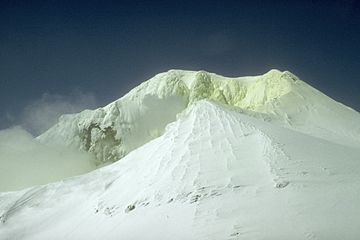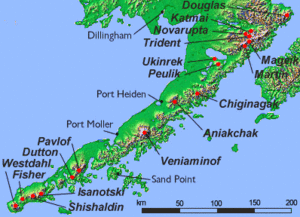Mount Martin (Alaska) facts for kids
Quick facts for kids Mount Martin. |
|
|---|---|

Summit crater of Mount Martin volcano, June 1990
|
|
| Highest point | |
| Elevation | 6,112 ft (1,863 m) |
| Prominence | 1,377 ft (420 m) |
| Geography | |
| Location | Katmai National Park and Preserve, Alaska, U.S. |
| Parent range | Aleutian Range |
| Topo map | USGS Adak C-2 |
| Geology | |
| Mountain type | Stratovolcano |
| Volcanic arc/belt | Aleutian Arc |
| Last eruption | February 1953 |
Mount Martin is a fascinating stratovolcano located in the United States. It's found on the Alaska Peninsula, a long piece of land stretching out from the main part of Alaska. This volcano is part of the amazing Katmai National Park and Preserve, a huge area known for its wild beauty and many volcanoes.
Mount Martin is quite special because it's very close to a famous place called the Valley of Ten Thousand Smokes. Even though it's a volcano, its peak only rises about 500 meters (1,640 feet) above the land around it.
Contents
About Mount Martin
Mount Martin is a type of volcano called a stratovolcano. This means it's shaped like a tall cone, built up over time by layers of hardened lava, ash, and rocks from past eruptions. It's considered a relatively young volcano. It sits on top of a ridge and partly covers older rock from a nearby volcano called Alagogshak.
Where is it?
Mount Martin is located in a very wild and remote part of Alaska. It's deep inside Katmai National Park and Preserve. This park is famous for its brown bears, salmon, and, of course, its many volcanoes. The park is a great place to learn about how Earth's forces shape our world.
What's Inside the Crater?
Even though Mount Martin hasn't had a confirmed eruption in a long time, its summit crater is very active! The crater is about 300 meters (984 feet) wide. It's often free of ice and snow, even in cold Alaska, because of the heat coming from below the ground.
Hot Vents and Lakes
Inside the crater, there's a lot of "fumarolic" activity. This means there are many vents, called fumaroles, that release hot steam and gases from deep within the volcano. These gases are so hot that they keep the crater warm. Sometimes, there's even an acidic crater lake that forms and disappears. The fumaroles also create large amounts of sulfur deposits, which look like yellow patches around the vents.
How Mount Martin Got Its Name
Mount Martin was named after a person named George C. Martin. He was a very important explorer. He was the first person to visit the famous Valley of Ten Thousand Smokes after a huge volcanic eruption happened there in 1912. That eruption came from a volcano called Novarupta, which is also in Katmai National Park. Naming the mountain after him was a way to honor his brave exploration.


